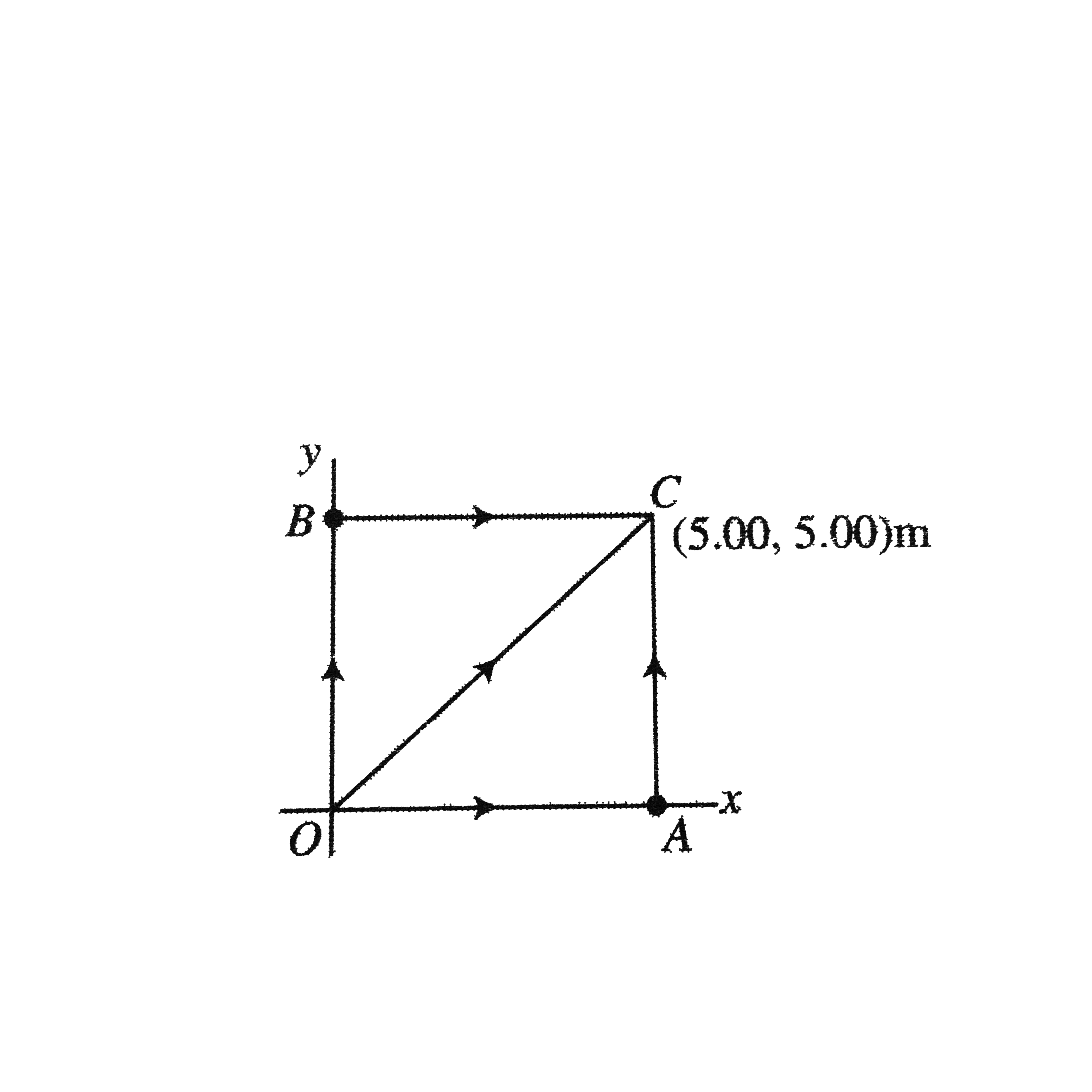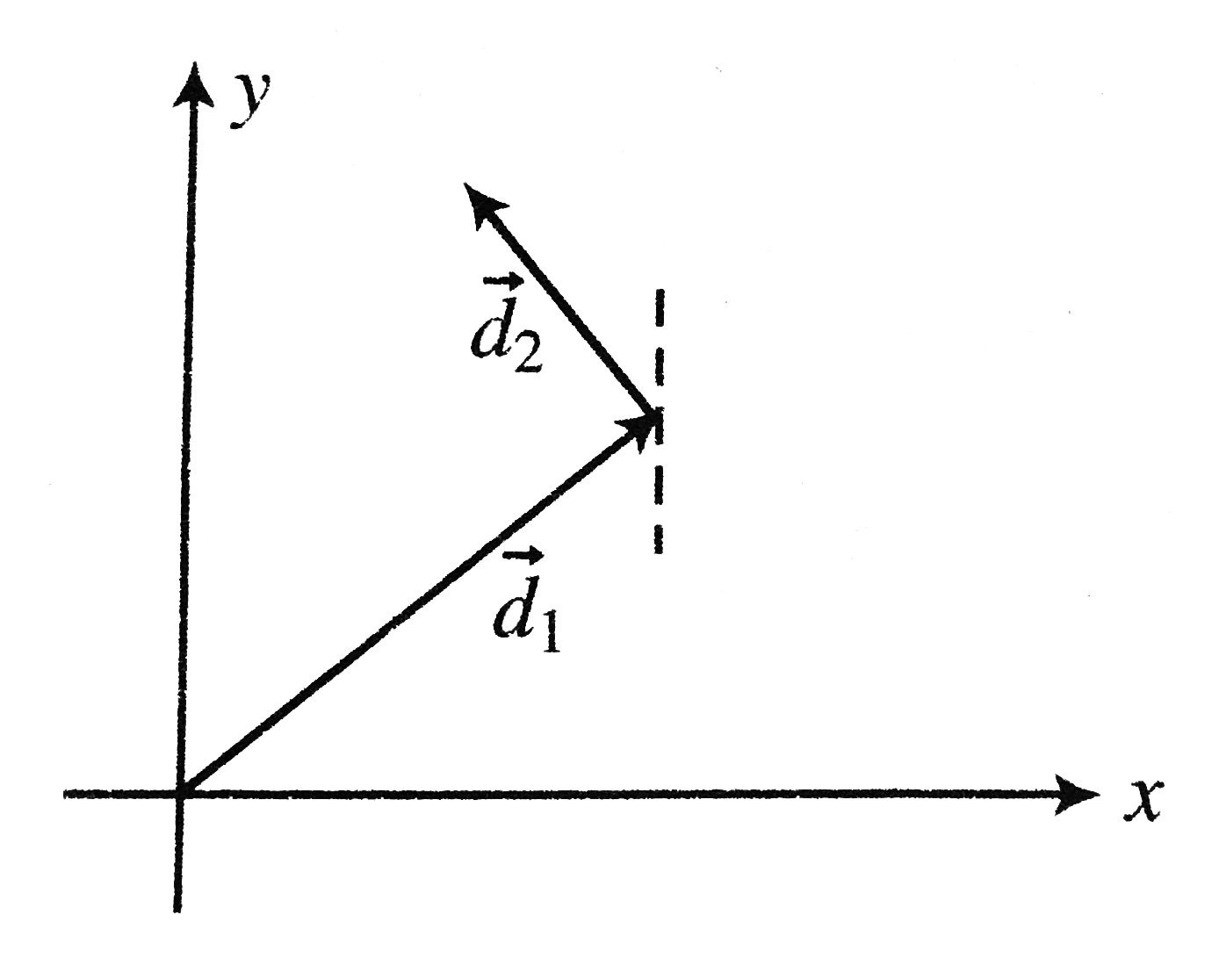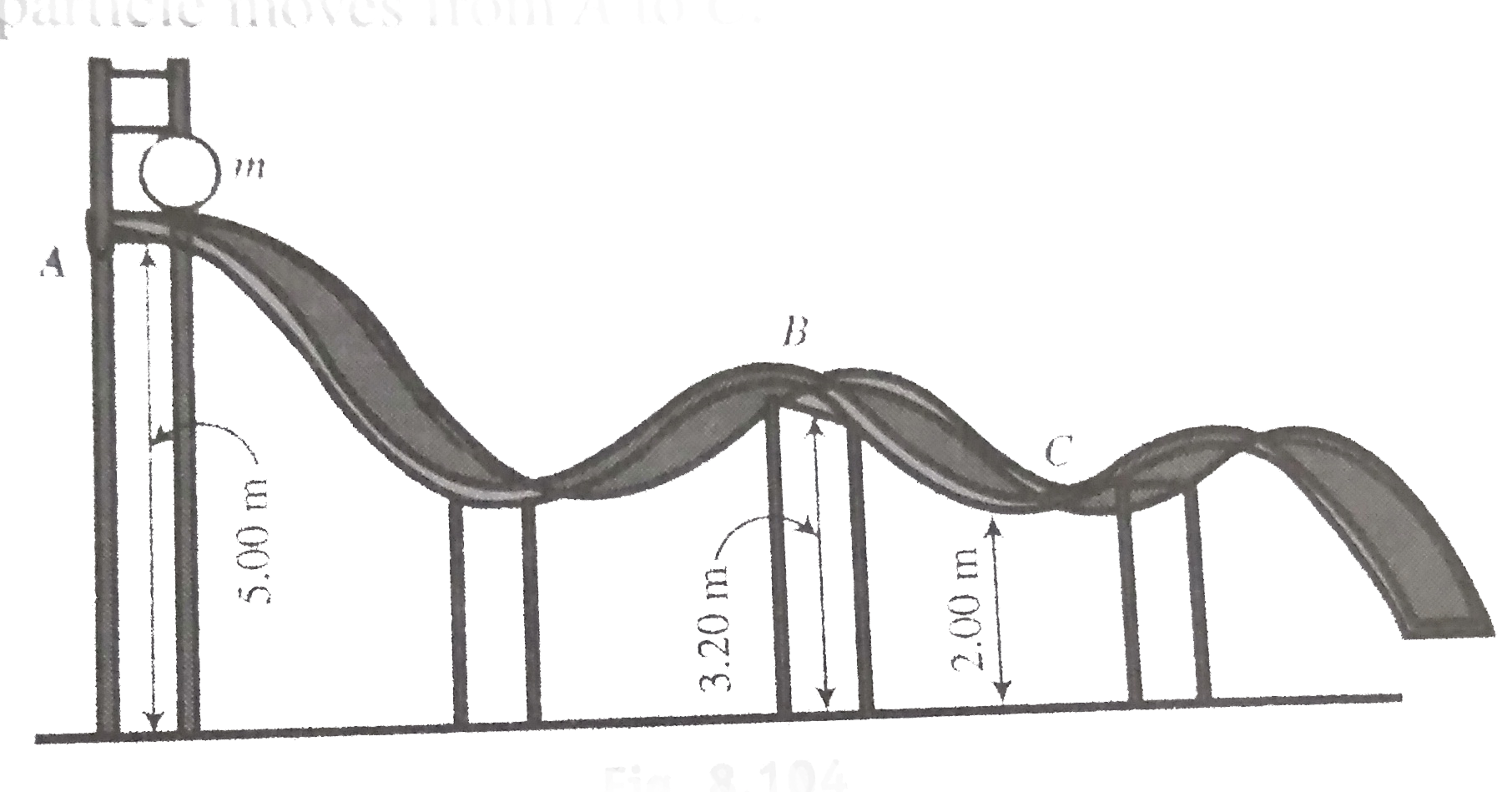A 4.00−kg particle moves from the origin to position C, having coordinate x=5.00m and y=5m. One force on the particle is the gravitational force acting in the negative y direction. Using equation W=FΔrcosθ=→F.Δ→r, calculate the work done by the gravitional force on the particle as it goes from O to C along (a) OAC, (b) OBC, and (c) OC. Your results should all be identical. Why?

Fg=mg=(4.00kg)(10.0ms−2)=40.0N
a. Work done along OAC=Work along OA+Work along AC
=Fg(OA)cos90.0∘+Fg(AC)cos180∘
=(40.0N)(5.00m)cos90∘+(40.0N)(5.00m)cos180∘=−200J
b. Work done along OBC=W along OB+W along BC
=(40.0)(5.00m)cos180∘+(40.0N)(5.00m)cos90.0∘=−200J
c. Work done along OC=FgOCcos135∘
=(40.0N)(5.00×√2m)(−1√2)=−200J
Work done is same in all cases because gravitational force is a conservative force.
Topper's Solved these Questions
- WORK, POWER & ENERGYBook:CENGAGE PHYSICS ENGLISHChapter:WORK, POWER & ENERGYExercise:Solved Examples
Explore 15 Videos
- WORK, POWER & ENERGYBook:CENGAGE PHYSICS ENGLISHChapter:WORK, POWER & ENERGYExercise:Exercise 8.1
Explore 25 Videos
- VECTORSBook:CENGAGE PHYSICS ENGLISHChapter:VECTORSExercise:Exercise Multiple Correct
Explore 5 Videos
Similar Questions
Figure. A smooth circular path of radius R on the horizontal plane which is quarter of a circle A block of mass m is taken from position A to B under the action of a constant force F. Calculate the work done by force F.
a. If it is always directed horizontally
b. If the block is pulled by a force F which is always tangential to the surface
c. Block is pulled with a constant force F which is always directed towards the point B
View SolutionDiscuss whether any work is being done by each of the following agents and, if so, whether the work is positive or negative: (a) a chicken scratching the ground, (b) a person studying, (c) a crane lifting a bucket of concrete, (d) the gravitational force on the bucket in part (c), and (e) the leg muscles of a person in the act of sitting down.
View SolutionWhich of the following statements is/ are correct(Figure)

View SolutionA 4.00−kg particle moves from the origin to position C, having coordinate x=5.00m and y=5m. One force on the particle is the gravitational force acting in the negative y direction. Using equation W=FΔrcosθ=→F.Δ→r, calculate the work done by the gravitional force on the particle as it goes from O to C along (a) OAC, (b) OBC, and (c) OC. Your results should all be identical. Why?

View SolutionA force acting on a particle moving in the x-y plane is given by vecF=(2yhati+x^2hatj)N , where x and y are in meters. The particle moves from the origin to a final position having coordinates x=5.00m as shown in figure. Calculate the work done by vecF on the particle as it moves along (a) OAC, (b) OBC, and (c) OC. (d) Is vecF conservative or non-conservative? Explain.
View SolutionA particle of mass m=5.00kg is released from point A and it slides on the frictionless track shown in figure. Determine (a) the particle's speed at points B and C and (b) the net work done by the gravitational force as the particle moves from A to C.

View SolutionA particle is moved along the different paths OAC, OBC & ODC as shown in the figure . Path ODC is a parabola , y=4x^(2) . Find the work done by a forc vec(F)=xyhat(i)+x^(2)y on the particle along these paths. Is this force a conservative force ?
View SolutionMatch of following columns {:(,"Column-I",,"Column-II"),("(A)",underset(underset("field is increasing")("particle in gravitational"))("Kinetic enery of a"),"(p)",underset(underset("be positive")("gravitational force should"))("Work done by")),("(B)",underset(underset("field is increasing")("particle in gravitational"))("Potential energy of a"),"(q)",underset("force should be non-zero")("Work done by external")),("(C)",underset(underset("field is increasing")("particle in gravitational"))("Mechanical energy of a"),"(r)",underset(underset("be negative")("gravitational force should"))("Work done by")),(,,"(s)","Cannot say anything"):}
View SolutionA force F acting on a particle varies with the position x as shown in figure. Find the work done by this force in displacing the particle from

View SolutionForce acting on a particle varies with x as shown in figure. Calculate the work done by the force as the particle moves from x = 0 to x = 6.0 m.
View SolutionA particle starts from rest from origin and moves along a parabolic path whose equation is y=x2 in the presence of a number of forces.One of the forces acting on the particle is F=(xˆi−4zˆk)N .Find work done by this force F when the particle moves from origin to x=2m.
View SolutionThe position vector →r of a particle points along the positive direction of a z axis. If the torque on the particle is (a) zero, (b) in the negative direction of x, and ( c) in the negative direction of y, in what direction is the force causing the torque?
View SolutionA force F=−K(yˆi+xˆj) (where K is a positive constant) acts on a particle moving in the x-y plane. Starting from the origin, the particle is taken along the positive x-axis to the point (a,0), and then parallel to the y-axis to the point (a,a). The total work done by the force F on the particle is
View SolutionMatch of following columns
Column-IColumn-II(A)Kinetic enery of aparticle in gravitationalfield is increasing(p)Work done bygravitational force shouldbe positive(B)Potential energy of aparticle in gravitationalfield is increasing(q)Work done by externalforce should be non-zero(C)Mechanical energy of aparticle in gravitationalfield is increasing(r)Work done bygravitational force shouldbe negative(s)Cannot say anything
View SolutionA force F acting on a particle varies with the position x as shown in figure. Find the work done by this force in displacing the particle from

View SolutionA particle is run from different paths according to the diagrams of OAC, OBC and ODC. ODC a parabola y = 4X^(2) is. A force on a particle vecF = xyhat(i) + x^(2)yhat(j) Is charged. Now answer the questions. The direction along the path OAC will be the work done by the force F on the particle.
View Solution
